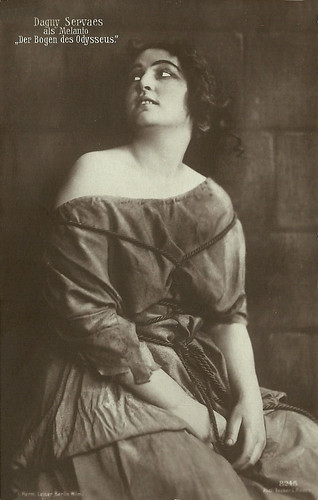
German postcard by Hermann Leiser, Berlin-Wilm., no. 8245. Photo: Becker & Maass. Dagny Servaes in 'Der Bogen des Odysseus'. Collection: Didier Hanson.
Dagny Servaes (1894-1961) was a German-Austrian theatre and film actress. She reached her peak in Ernst Lubitsch Das Weib des Pharao/The Pharao's Wife (1921).

German postcard by Verlag Herm. Leiser, Berlin-Wilm., no. 8334. Photo: Becker & Maass. Caption: Helene Thimig as Solveig in 'Peer Gynt'. Thimig appeared in the play by Henrik Ibsen in 1914-1915.
Austrian actress Helene Thimig (1889-1974) was an important stage performer during the Weimar Republic. She came from a renowned acting family: she was the daughter of Hugo Thimig and the sister of Hermann Thimig and Hans Thimig. She fled the Nazis with her later husband, theatre producer/director Max Reinhardt, sought refuge in Hollywood, and appeared in 18 Hollywood films. After the war, she returned to Vienna where she had a prolific stage career but only sporadically appeared in films.

German postcard by Verlag Hermann Leiser, Berlin-Wilm., no. 8366. Photo: Hänse Herrmann. Joseph Schildkraut as Oberon in a German stage production of 'A Midsummer Night's Dream'.
Joseph Schildkraut (1896-1964) was an Austrian-American actor. He started his career in the silent German cinema and became a matinée idol in silent Hollywood. Schildkraut won an Oscar for his performance as Captain Alfred Dreyfus in the film The Life of Emile Zola (1937). Later he was nominated for a Golden Globe for his performance as Otto Frank in the film The Diary of Anne Frank (1959) and a Primetime Emmy for his performance as Rabbi Gottlieb in a 1962 episode of the television series Sam Benedict.

German postcard by Verlag Hermann Leiser, Berlin-Wilm., no. 8378. Photo: Hänse Herrmann. Joseph Schildkraut.
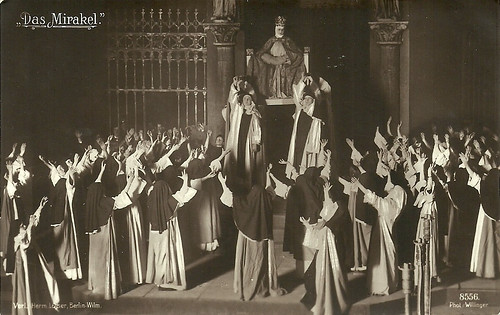
German postcard by Verlag Hermann Leiser, Berlin-Wilm., no. 8556. Photo: Willinger. Maria Carmi in the stage play (1911) or the Austrian-British film Das Mirakel/The Miracle (1912).
With her aristocratic air, her severe looks but also her sweet undertones, Italian silent film star and stage actress Maria Carmi (1880-1957) was the cinematic translation of the 19th century Primadonna. Later she became Princess Norina Matchabelli and was co-founder of the perfume company Prince Matchabelli.

German postcard by Verlag Hermann Leiser, Berlin, no. 8615. Photo: Hofphot. E. Bieber, Hamburg. Collection: Didier Hanson.
German actor-director Max Reinhardt (1873-1943) was one of the great innovators of the theatre. He also directed several films, including Sumurûn (1910) and Das Mirakel (1912). In 1934, he went into exile and made in Hollywood A Midsummer Night's Dream (1935).
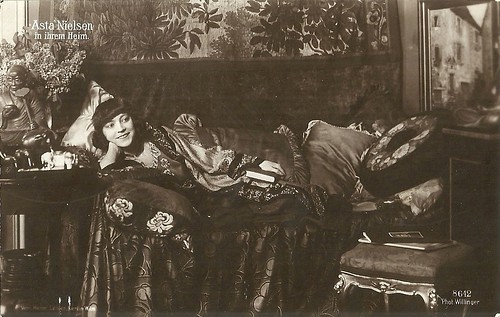
German postcard by Verlag Hermann Leiser, Berlin-Wilmersdorf, no. 8642. Photo: Willinger. Asta Nielsen in ihrem Heim (at home).
Willinger probably refers to the Jewish Austrian photographer Wilhelm Willinger (1879-1943), born in Budapest in what was then the Austrian-Hungarian Empire. Until 1900 he was active in Budapest, where he did so well that he was elected to the Board of Photographers in 1897. Between 1902 (or 1909) and 1918, he had his own film studio in Berlin, while maintaining a studio in Pest. Willinger was known for his portraits of the early silent film era, which were also issued as postcards.

German postcard by Verlag Hermann Leiser, Berlin-Wilmersdorf, no. 8643. Photo: Willinger. Asta Nielsen in ihrem Heim (at home). Nielsen wears the dress and hat from her film Die falsche Asta Nielsen (Urban Gad, 1915).
Danish silent film actress Asta Nielsen (1881-1972) was one of the most popular leading ladies of the 1910s and one of the first international film stars. Of her 74 films between 1910 and 1932, seventy were made in Germany where she was known simply as "Die Asta". Noted for her large dark eyes, mask-like face and boyish figure, Nielsen most often portrayed strong-willed passionate women trapped by tragic consequences.
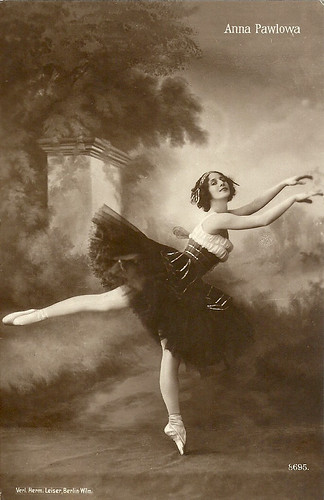
German postcard by Verlag Hermann Leiser, Berlin-Wilm., no. 8695. Collection: Didier Hanson.
Anna Pavlova (Russian: Анна Павлова; 1881–1931) was a Russian prima ballerina of the late 19th and the early 20th centuries. She was a principal artist of the Imperial Russian Ballet and the Ballets Russes of Sergei Diaghilev. Pavlova is most recognised for the creation of the role The Dying Swan and, with her own company, she became the first ballerina to tour ballet around the world.

German postcard by Verlag Herm. Leiser, Berlin-Wilm., no. 8747. Photo: Becker & Maass. Helene Thimig as Gretchen in Max Reinhardt's stage production of Goethe's 'Faust' (1920).
Austrian actress Helene Thimig (1889-1974) was an important stage performer during the Weimar Republic. She came from a renowned acting family: she was the daughter of Hugo Thimig and the sister of Hermann Thimig and Hans Thimig. She fled the Nazis with her later husband, theatre producer/director Max Reinhardt, sought refuge in Hollywood, and appeared in 18 Hollywood films. After the war, she returned to Vienna where she had a prolific stage career but only sporadically appeared in films.
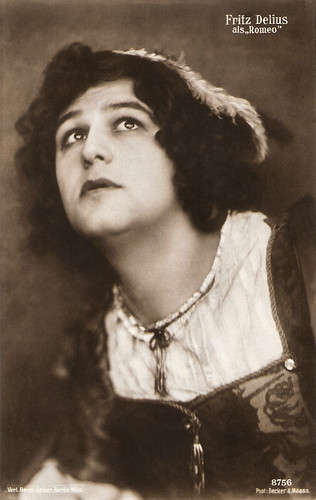
German postcard by Herm. Leiser, Berlin-Wilm., no. 8756. Photo: Becker & Maass. Fritz Delius as Romeo in 'Romeo and Juliet' by William Shakespeare, probably under the direction of Max Reinhardt, ca. 1913.
Fritz Delius was a German stage and screen actor, born 28 September 1890 in Berlin, Germany, and died 20 September 1966 in Basel, Switzerland.

German postcard by Verlag Hermann Leiser, Berlin-Wilm., no. 9005. Photo: Zander & Labisch. Curt Vespermann in 'Friederike'.
German character actor Curt Vespermann (1887-1957) was active in nearly 200 films between 1915 and 1957.

German postcard by Verlag Herm. Leiser, Berlin-Wilm., no. 9009. Photo: Eli Marcus. Fritz Kortner in the play 'Der rote General' (1928) by Hermann Ungar.
Austrian-born stage and film actor and theatre director Fritz Kortner (1892-1970) was one of the best-known character actors of German silent cinema. His speciality was playing sinister and threatening roles.

German postcard by Verlag Hermann Leiser, Berlin, no. 9143. Photo: Fritz Richard. Bruno Decarli as Robespierre in the play 'Dantons Tod' (Danton's Death) by Georg Büchner.
'Danton's Death' (Dantons Tod) was the first play written by Georg Büchner, set during the French Revolution. It was written in 1835 but only first performed in 1902. Decarli played Robespierre on stage under the direction of Max Reinhardt in 1916 at the Deutsches Theater in Berlin. He was such a success in this part that he reprised it in 1921 in Berlin and in 1929 in Dresden. Because of the success of the 1921 version, Dimitri Buchowetzki would adapt it the same year for his film Danton, with Emil Jannings as Danton and Werner Krauss as Robespierre.
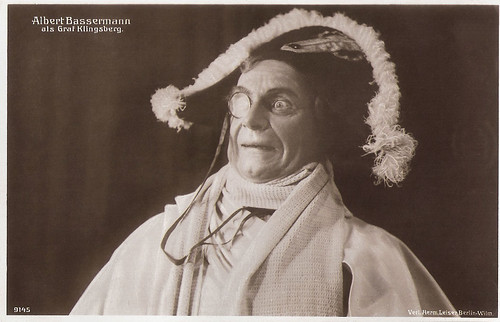
German postcard by Verlag Hermann Leiser, Berlin-Wilm., no. 9145. Albert Bassermann as Graf Klingsberg in the play 'Die beiden Klingsberg' by August von Kotzebue.
Albert Bassermann (1867–1952) was one of the first great German stage actors who worked for the cinema. In 1933 he fled the Nazi regime and became an Oscar-nominated stage and film actor in the US.

German postcard by Verlag Herm. Leiser, Berlin-Wilm., no. 9175. Photo: Käthe Hirschfeld.
Theodor Loos (1883-1954) was a German stage and screen actor between the 1910s and the 1950s. He became famous for his parts in Fritz Lang’s German films.

German postcard by Verlag Hermann Leiser, Berlin-Wilmersdorf, no. 9179.
German actor Carl de Vogt (1885-1970) was a kind of Indiana Jones in the silent films of Fritz Lang. De Vogt was also a popular singer and made several records in the 1920s.
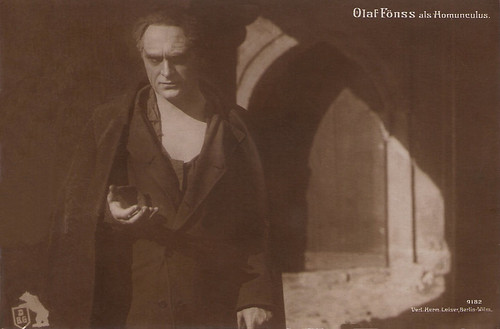
German postcard by Verlag Herm. Leiser, Berlin, no. 9182. Photo: DBG (Deutsche Bioscop-Gesellschaft). Olaf Fønss in Homunculus, 5. Teil. Die Vernichtung der Menschheit/ Homunculus (Otto Rippert, 1916).
Olaf Fønss (1882-1949) was one of Denmark and Germany's biggest stars of the silent film era. He also worked as a film director, producer and censor.

German postcard by Verlag Hermann Leiser, Berlin-Wilm., no. 9256. Photo: Zander & Labisch. Wanda Treumann and Viggo Larsen in one of their films.
Wanda Treumann (1883–1963) belonged among the most popular stars of German cinema before the First World War. Together with Viggo Larsen she also produced more than 80 films in the 1910s, in which she often played the female lead. As an actress, she played in nearly 90 films, but many of them were shorts.

German postcard by Verlag Hermann Leiser, Berlin-Wilm., no. 9281.
German actress and dancer Rita Sacchetto (1879-1959) was in the 1910s a star of the Danish Nordisk Film Company.

German postcard by Verlag Hermann Leiser, Berlin-Wilm., no. 9303. Photo: Zander & Labisch. Paul Hartmann in Volk in Not/People in Need (Wolfgang Neff, 1925).
German stage actor Paul Hartmann (1889-1977) made over 100 films, both in the silent and the sound period. Despite his commitment to the Nazi regime, he could continue his career quite smoothly into the 1950s and 1960s.
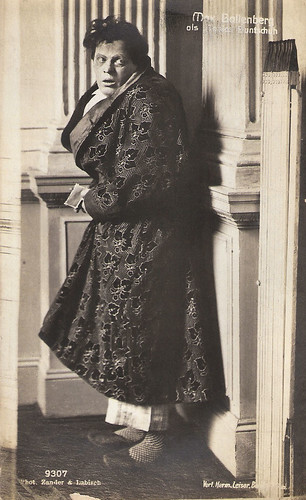
German postcard by Verlag Herm. Leiser, Berlin-Wilm., no. 9307. Photo: Zander & Labisch. Max Pallenberg in the play 'Tobias Buntschuh' (1917).
Max Pallenberg (1877-1934) was an Austrian singer, actor and comedian. He was one of the most important comedians of his time and often played under the direction of Max Reinhardt. Although Pallenberg was successful as a stage comedian, he only incidentally accepted roles in films.
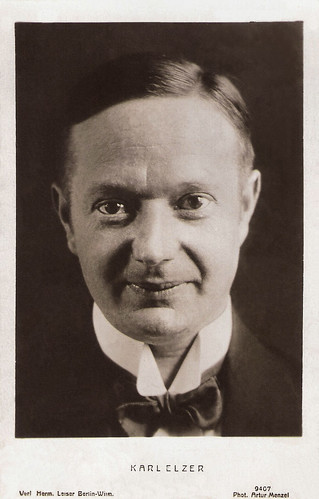
German postcard by Verlag Hermann Leiser, Berlin-Wilm, no. 9407. Photo: Arthur Menzel.
Karl Elzer (1881-1938) was a German supporting actor on the Berlin stage and in silent films. He was a child performer from the age of eight. He was most prominent in films of the 1920s, often in the role of industrialists or nobility. His films included Die blaue Laterne (1918), Maud Rockfellers Wette (1924) and Luther (1928).
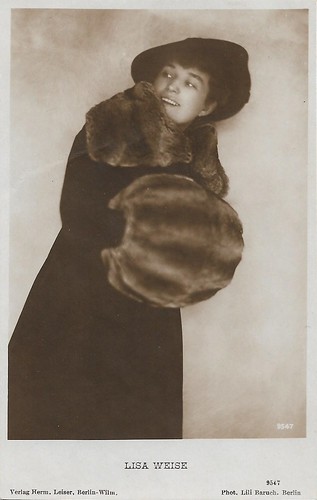
German postcard by Verlag Hermann Leiser, Berlin-Wilm., no. 9547. Photo: Lili Baruch, Berlin.
German actress Lisa Weise (?-1952) starred in silent films of the 1910s. Most of her films were directed by Friedrich Zelnik and often her film partner was Karl Beckersachs.
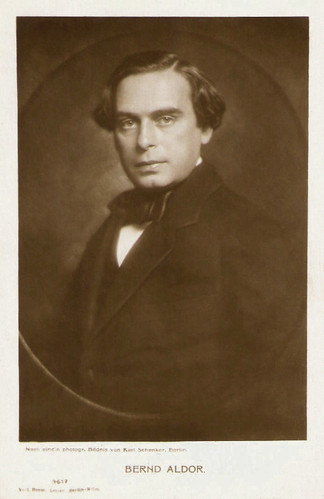
German postcard by Verlag Hermann Leiser, Berlin-Wilm., no. 9617. Photo: Karl Schenker, Berlin.
Bernd Aldor (1881-1950) was a star of the German silent cinema in the 1910s and 1920s, often in films by Richard Oswald or Lupu Pick. Sound film and the Nazi regime broke the career of this Jewish actor.
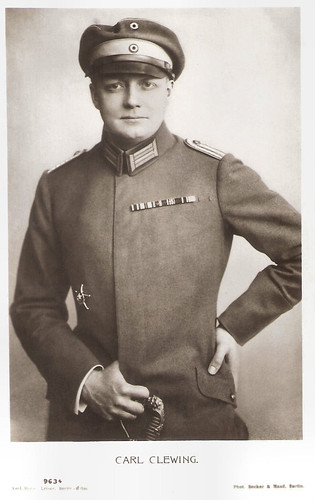
German postcard by Verlag Herm. Leiser, Berlin-Wilm., no. 9634. Photo: Becker & Maass.
German actor Carl Clewing (1884-1954) was an opera singer, the composer of the song 'Alle Tage ist kein Sonntag' (Not Every Day is a Sunday) and a Music professor in Berlin During the years of the early cinema he was much in demand as a film actor.
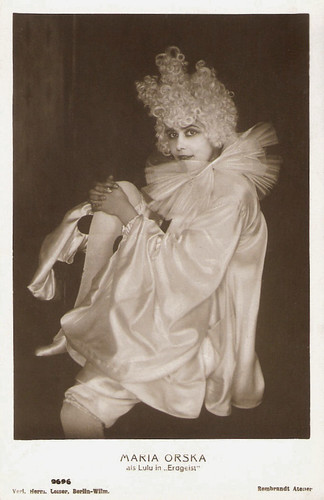
German postcard by Verlag Hermann Leiser, Berlin-Wilm., no. 9696. Photo: Rembrandt Atelier. Maria Orska in her role as Lulu in the stage play 'Erdgeist' (Earth Spirit) by Franz Wedekind directed in 1916 by Max Reinhardt.
Maria Orska (1893-1930) was a Russian-Jewish actress on the German stage and screen in the 1910s and 1920s.

German postcard by Verlag Hermann Leiser, Berlin-Wilm., no. 9923. Carl de Vogt as the title character in Friedrich Werders Sendung (Otto Rippert, 1916), scripted by Hans Land (Hugo Landsberger) on whose novel (1915) the film was based.
German actor Carl de Vogt (1885-1970) was a kind of Indiana Jones in the silent films of Fritz Lang. De Vogt was also a popular singer and made several records in the 1920s.

German postcard by Verlag Herm. Leiser, Berlin-Wilm., no. 9977. Photo: Gerlach.
French comedian Max Linder (1883-1925), with his trademark silk hat, stick and moustache was an influential pioneer of silent film. He was largely responsible for the creation of the classic style of silent slapstick comedy and he was the highest-paid entertainer of his day.

German postcard by Verlag Hermann Leiser, no. 9990. Photo: Fritz Richard. Caption: Paul Wegener as Othello.
German actor, writer and film director Paul Wegener (1874-1948) is one of the true fathers of the horror and fantasy genre, particularly remembered for his three silent films centred around the Jewish legend of the Golem. Wegener was one of the pioneers of German cinema who realized the potential of the new medium and used the possibilities of cinematic trick photography as a method for presenting fantastic tales in a serious matter.
No comments:
Post a Comment